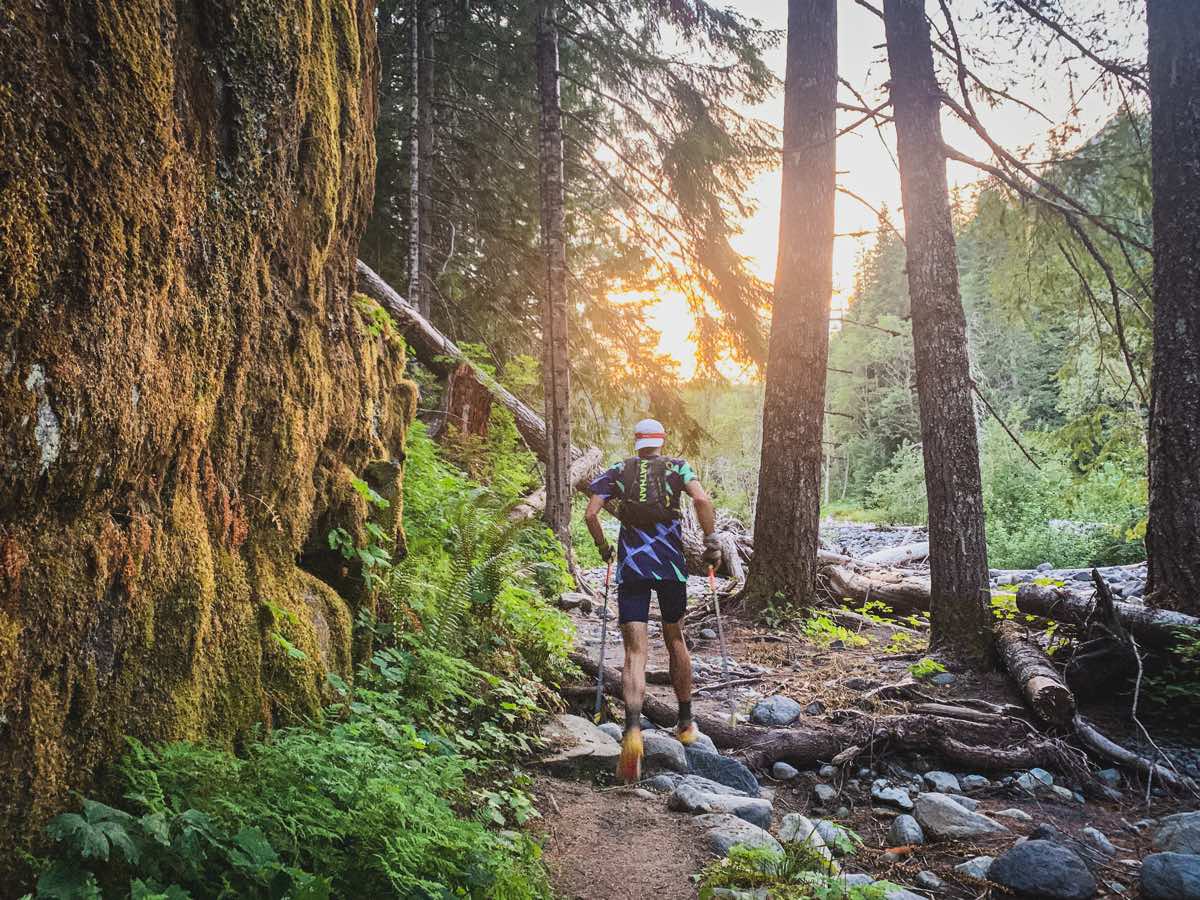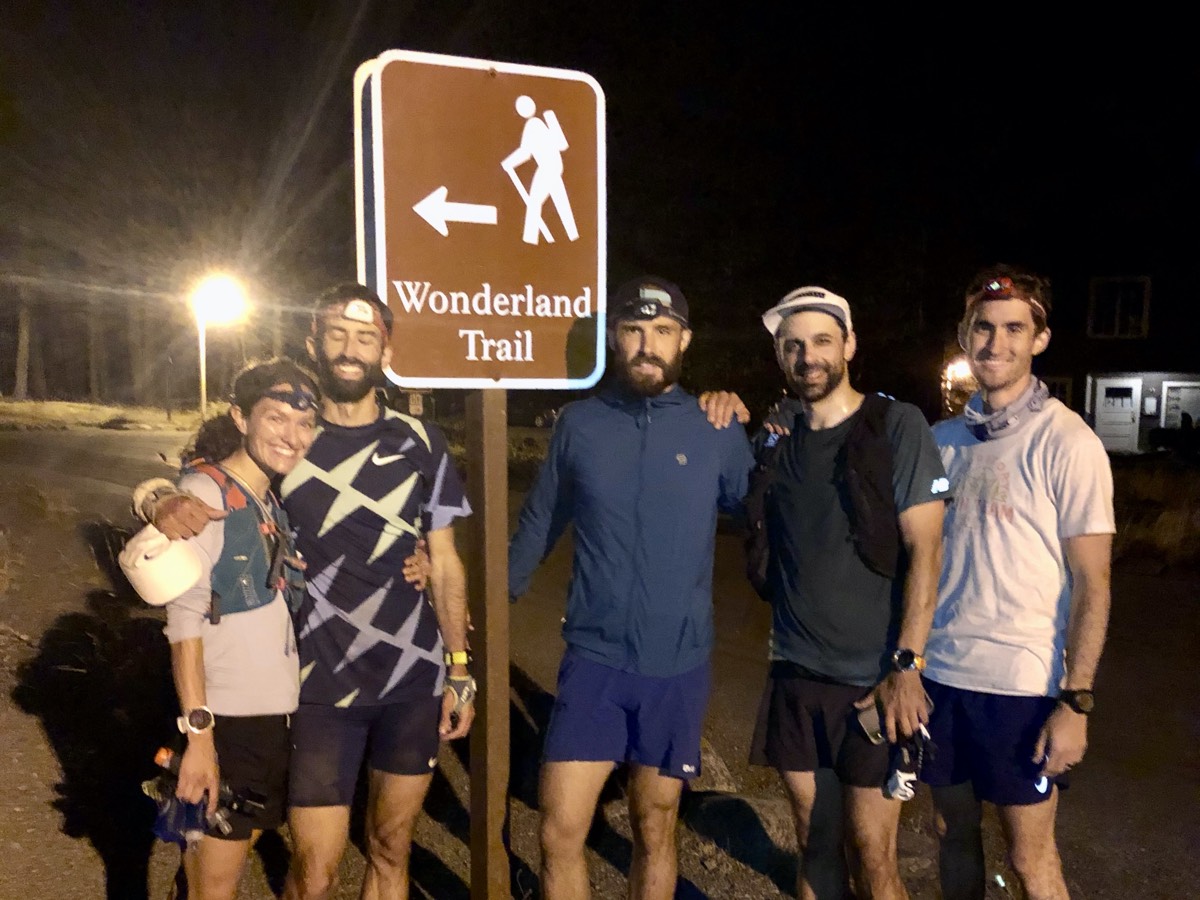It’s the year of fastest known time (FKT) efforts! On August 24, Tyler Green set a new Wonderland Trail men’s supported FKT at 16 hours, 40 minutes, and 55 seconds. Washington state’s Wonderland Trail is about 93 miles long, has roughly 24,000 feet of climbing, and encircles Mount Rainier. Tyler’s effort came just five days after Dylan Bowman’s successful FKT effort, which at the time lowered the record by nearly 90 minutes to 16 hours, 58 minutes, and 41 seconds. Tyler’s run thus improved the men’s supported FKT by about 18 minutes. In this interview, Tyler talks about replacing a summer of racing with a summer of FKT efforts, how he’s been building toward a Wonderland Trail speed effort, how Dylan’s performance just a few days before helped him to run harder than he thought he could, and what the Wonderland Trail means to him.

Tyler Green after setting a new men’s supported FKT on the Wonderland Trail. All photos courtesy of Tyler Green.
iRunFar: Congratulations, Tyler! What a week it’s been on the Wonderland Trail. We’ve seen you race a bunch of times over the years, but this is our first time interviewing you. I’d love to learn about you.
Tyler Green: Yeah! I am a middle-school health teacher, and I live on campus at a private boarding school outside of Portland, Oregon. So, I work as a boarding-school dorm parent, along with my wife Rachel Drake, who’s also a professional runner for Nike. She’s a medical student and PhD candidate in research as well.
The two of us love to run. My first ultramarathon was the McKenzie River 50k, just east of Eugene. I ran it one year and said, “I’m never going to do another ultra.” The next year I signed up for about five of them, and I actually met Rachel at the McKenzie River 50k a few years after that. I mean, every part of ultrarunning is fun, but the best part is that I got to meet my wife through it.
iRunFar: Aw. Did you come up in running? Did you run as a kid?
Green: I think I started in second grade. I had my first cross-country race then. I ran for a number of years, up through high school, and then one year in college.
Then I moved away and lived in Nepal for a couple years. I did a lot of community-service projects. I hiked around the mountains for nearly two years for that. I attribute a lot of my development, especially at powerhiking, to those two years of hiking. They don’t really have switchbacks there. They just go straight. And then after that I actually got into biking. I did some road cycling, mountain biking, and cyclocross. I felt I was kind of done with running.
But we have this trail in Portland, the 30-mile Wildwood Trail. I just started saying, “Oh, I’m going to do that in little sections.” So I would go out and do little runs on it until I saw the entire trail a couple times. Those runs got longer, and then I started thinking about some other things that I wanted to do, like the 40-mile Timberline Trail around Mount Hood. That was a real clincher. I ran the Timberline Trail and absolutely loved it. I said, “This is what I want to be doing.”
iRunFar: It is irresistible to not ask you what it’s like to be a middle-school health teacher in a COVID-19 pandemic.
Green: We shut everything down in March, shortly before spring break, and went all online. We will continue online at the start of this year, until we can go into a hybrid model once the Oregon Department of Education gives us the okay for that.
I love middle-school students. It’s a unique age. Not everybody gets along with them super well, but I think they’re absolutely hilarious. In COVID-19 times, it’s particularly difficult. The one-on-one time is so important, and it’s just not the same without that. We’re trying to find creative ways to build community.
That’s one of the coolest things about our program [in normal times], this opportunity to live with people from all over the world and share experiences and learn together. To not have that face-to-face interaction right now is hard.
iRunFar: It sounds rough. I think of you as a fairly prolific racer. With no racing this year, you are putting your eggs in the FKT basket.
Green: Yeah. I had great plans for this year. I was going to go to the Gaoligong by UTMB race, and I was signed up for the Eiger Ultra Trail. I did three 100 milers last year, the Western States 100, Cascade Crest 100 Mile, and Javelina Jundred. It was so clear to me that I was best suited to Cascade Crest. So I wanted to get more races in the mountains and continue to develop in that realm. When everything was canceled, I decided to put my eggs into one basket with the Wonderland.
iRunFar: So, the build-up. You were using your other FKT efforts to build up to the Wonderlands Trail?
Green: Yes, definitely. It’s been on my mind for a while. Once things were canceled and I could see the writing on the wall, I said, “Well, I have the Timberline Trail FKT right now, and I’d really like to have the FKTs for the 30-mile Loowit Trail around Mount St. Helens and the Wonderland Trail around Mount Rainier. Just to hold them all maybe for one day, that’d be great.”
iRunFar: As an outsider to the Pacific Northwest, because people speak so highly of it, the Wonderland Trail is on my personal bucket list. Is it the same for those of you up there, who are closer?
Green: In Portland, the Timberline Trail is what we all do. Everybody does it in a day, and it’s the fun adventure that you do with your friends. The Wonderland Trail is bigger. My wife and I did it last year in a three-day fastpack, and had a tough time doing it. Multiple times we were like, “This is a burly mountain, far beyond what you see on Mount Hood on the Timberline Trail.” All that to say yes, I think it has this allure, and it’s also big and daunting.
iRunFar: Got it. So, how did you transition from that intimidated place from when you fastpacked it to, “Yes, I am confident in my ability to run it fast in one go?”
Green: Last year was a really good year of development for me. I built confidence as a 100-mile racer. I don’t know if I raced 100% to my potential in any of those races, but I just wanted to learn how to do it, and that has helped me to push off the scariness of 100 milers.
I look at people like Jeff Browning or Mark Hammond. The guys who are really good and consistent at 100 milers do a lot of them. I looked at them and said, “That’s what I’m going to try to do. I’m going to do a few of them and figure them out.”
iRunFar: I have to ask, did you know that Dylan Bowman was working toward an FKT effort too?
Green: Yeah. We were on a run together, and we knew that the Hardrock 100 which he was signed up for was uncertain. I said, “So, what are you going to do if Hardrock is canceled?” And I knew what he was going to say. He said, “Oh, I’m going to go for Wonderland.”
iRunFar: Did you fess up that this was your goal, too?
Green: Yeah, I did. We knew we were both going after it. He was very sneaky about a lot of the data and stuff. He didn’t show that he had gone up there at all [to train on the trail]. And he didn’t put it his FKT data up on his Strava for a little while.
iRunFar: He knew you were looming out there somewhere. And is it a coincidence that your efforts ended up being so close?
Green: Yeah. I had actually put it on my calendar for late July, and I worked through an injury in the late spring, early summer, so I had to push it back quite a bit.
iRunFar: Let’s talk about your day. You must have been working up a set of splits based on Ryan Ghelfi’s [the record holder prior to Dylan] time. But then a couple days before you start, there’s a whole new time category you’re shooting for courtesy of Dylan. What was that like?
Green: When Dylan was running, I was checking all of his updates and feeling really worried. And then I made the mistake of checking his finishing time in the middle of the night when I was trying to sleep. When I saw his time, I blinked twice and was like, “That’s not real.” I didn’t sleep very well that night. It really took me the full five days to reframe my mind around the new time.
I was pretty unsure about whether I could do it, but I had a lot of friends who said I could and encouraged me. That was pretty amazing. I really think that they believed in me before I believed in myself. They were able to coax me into believing that it was possible.
iRunFar: When it was actually go time, were you modeling yourself after what Dylan had done?
Green: Not really. I only had one split to Mowich Lake in six hours, which is 30-some miles into the route.
iRunFar: Oh, wow. You had Dylan’s six-hour split for the first 30-some miles and that’s it. What did you come through in?
Green: I think it was 5:52. And I also got lost for about four minutes in the first water crossing. So I was like, “Whoa. Okay, I’m going pretty fast.”
I definitely got some good confidence from being under that split. My mentality after that was, “You’re not going to walk out of this day saying that you didn’t try. You have to go for it.” And if that meant my legs not working on the way up to Panhandle Gap, then so be it. So, I had a really great descent. And then it’s one of the biggest climbs of the day to get up to Mystic Lake, and then there’s a little descent and another climb. I had forgotten about that second climb up to Sunrise, and that was a low point.
I think my lowest points were whenever I had forgotten about a climb, basically. I thought I had the profile in my head, and I just slipped on a couple things. So, I got to White River feeling like I was pretty much done, and didn’t really want to continue. But my crew, we never really even talked about it. I just got in there, and they kind of shuttled me straight out.
That is the one change of strategy that I had, was that we just said, “We’re not going to stop. We’re going to get through each point, and you’re going to walk with me. And we’re just going to keep going, and not even sit down or stand.”
iRunFar: What was your pacer and crew situation like?
Green: We’re just a ragtag bunch! It was my wife and three friends. So, the idea was that Rachel ran out from Mowich Lake and intercepted me and ran me in. Then Brandon Drake was supposed to run the entire way to White River with me. Another friend, Sean Haworth, was going to run to Box Canyon with me. Both of them, I’d say we ran about halfway together for most of them. And Jordan Carey paced me on the final stretch.
iRunFar: I guess maybe you already answered my next question. Did it not feel in the bag at all? It was just hammer all the way to the end, and see how it pans out?
Green: My mentality was that I was ahead of Dylan’s schedule at Mowich Lake. By the time I got to White River, I thought I had lost all of that time. I was kind of unsure about the splits, so I didn’t know for sure. But I figured, “Well, if I’m losing time on him now, I’m not going to gain that time back. I’m going to keep losing it.” In Box Canyon I thought I was done, and I was thinking, “This is going to be so cruel, that I’m going to finish in 17:05 or 17:10.” I got to Box Canyon, and it took a while for my crew to convince me that I was actually still in it, maybe even ahead.
iRunFar: And so, you finish, and you end up 18 minutes ahead?
Green: Fastest Known Time has it verified as 16:40:55. Which is cool. It’s 1,000 minutes, or actually 1,001 minutes.
iRunFar: Oh, no way! A couple days later now, how are you feeling?
Green: I’m still a little sore. We have a new dog, and he’s stepping on my toes a lot.
iRunFar: You and Dylan combined really moved the needle on this one. One of the things that I think is so cool about the FKT concept is that we stand on the shoulders of those who preceded us even if they are not with us in the moment. What do you say to somebody else who’s out there dreaming of the Wonderland Trail?
Green: I just want to reiterate that there is no way that I would have run 16:40 without Dylan first running south of 17:00, and having that to chase. I think it can go faster. I think you have to take care of those little things. I’d say it takes you being really invested in the route, and to have a desire to enjoy this journey.
iRunFar: That’s a sentiment I’ve heard from other people who’ve done FKTs this summer, is that there’s a certain love of place that’s more evolved.
Green: Yeah, there’s something about a bucket-list idea. It has to be something that’s been milling around in your head for a really long time.
iRunFar: Loving what you do.
Green: Yeah, loving what you do, and loving the route itself.
iRunFar: Congratulations to you!



